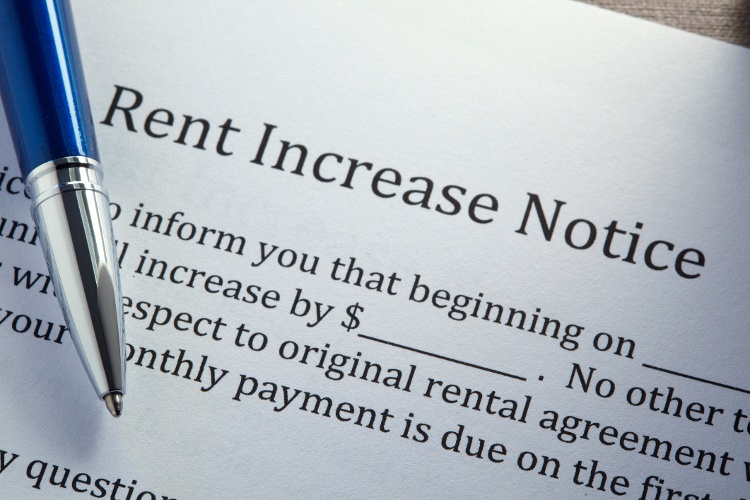It’s probably safe to say that most tenants expect an annual rent increase (even your good tenants). After all, prices on everything else usually go up, thanks in large part to inflation, so why shouldn’t the rent?
But it’s also safe to say that even though a tenant may expect the rent to go up, the odds are they aren’t looking forward to paying more rent. As a rental property investor, part of your job is to make a monthly rent increase that feels reasonable to the tenant.
Here’s how to determine what a reasonable rent increase is, to help keep your occupancy levels high and your rental income robust.
Reasons for Increasing the Rent
One of the keys to profitable rental property investing is keeping your rent rate competitive.
Your rent doesn’t necessarily have to be the highest in the market. In fact, some investors intentionally under-price their rent by a few percent below the fair market rate. While they may not be making as much money as possible, they believe the tradeoff is that occupancy rates will be as close to 100% as possible with tenants renewing their lease year after year.
As a real estate investor, the rent pricing strategy you choose is up to you. Of course, you can adjust your strategy from one year to the next, based on the local market place and how strong or weak the economy is.
However, regardless of whether your rents are at the top, middle, or low end of the market, it’s still important to understand the main reasons for increasing the rent.
Fixed expenses
Fixed operating expenses in a rental property are ones that you have little or no control over, such as:
- Property management fees
- Leasing fees
- Utilities
- Property taxes
- Mortgage payment with an adjustable interest rate (ARM)
- Property and landlord liability insurance
- Property and rental taxes
- HOA fees and special assessments
To be fair, some of these expenses are controllable before you purchase the property.
For example, choosing a fixed-rate mortgage over one with an adjustable rate keeps your principal and interest payments the same year after year. Or, thoroughly researching the homeowner association to make sure they’re well-capitalized before you buy a home in an HOA can help avoid an unexpected special assessment.
But once you’ve made the decision on what to buy and how to finance, these expenses can be extremely difficult to control.
Variable expenses
Variable operating expenses in a rental property are one that you may be able to reduce, such as:
- Routine maintenance expenses such as landscaping, pest control, and seasonal maintenance such as winterizing doors and windows, HVAC servicing, and gutter cleaning
- Repairs such as loose electrical outlets, leaking faucets and drain pipes, clogged disposal or toilet, and sidewalk crack repairs
- Vacancy downtime minimized with pro-active leasing such as marketing the property for lease before the current tenant vacates and offering the current tenant incentives to renew the lease.
One of the best and easiest ways to reduce variable expenses without cutting corners is to hire an experienced local property manager.
That’s because property management companies usually have “master accounts” with local vendors, contractors, and handymen. In exchange for giving the supplier more business, the property manager receives a volume service discount, which can then be passed through directly to you.
Profit margin
In the 1987 movie Wall Street, the ruthless investor Gordon Gekko famously said that, “Greed, for lack of a better word, is good.”
While you don’t have to be a corporate raider to own real estate, it is important to remember that investing in rental property is a business that is supposed to make money.
If you can find ways to lower your operating expenses without harming your property value, or if you discover that rents for comparable property like yours are higher priced, go ahead and increase rent to match what your competition is collecting.

Determine the Fair Market Rent
In the above section, we discussed the expenses of owning and operating a rental property, and how growing costs can create the need for raising the rent. However, the local real estate market creates a “glass ceiling” that can limit how much rent an investor can charge.
If you try to charge a higher rent than comparable properties in your neighborhood, tenants will look elsewhere, your vacancy rate will rise, and your cash flow will suffer. So, to avoid accidentally overpricing your rent, you’ll need to know what the going rents in your market really are.
Resources to use for researching fair market rent include:
Zillow
Zillow provides data on past and current median rents by town, city, and state. In addition to a macro value, you can also dig deeper by segmenting Zillow’s rent index by:
- Home type – single-family rental, condo / co-op, duplex / triplex
- Number of bedrooms – studios, and from 1 to 5+ bedrooms
- Price tier – top, middle, and bottom
RENTCafé
RENTCafé provides rental market trends for most places in the U.S. Rent market trend data on the site includes important information such as:
- Average rent
- Year-over-year rent change (Y-o-Y)
- Average apartment size
- Apartment rent ranges
- Percentage of renter-occupied households
- Historical rent trends
- Average rent by largest neighborhoods
- Neighborhoods that are the most popular, most expensive, and most affordable for renters
Although RENTCafé tracks average rents for apartments, the site is still a great tool for single-family home investors to use.
That’s because local apartment rents can serve as a benchmark for setting the market rent for a house or small multifamily property since a large percentage of tenants see renting their own home as being the most desirable rental property option.
As Multifamily Executive (MFE) has reported, the single-family rental is booming because houses fill lifestyle needs that apartment communities can’t match.
Rentometer
Rentometer indicates if the rent is too high, too low, or just right by comparing the current rent with other local properties. While Zillow and RENTCafé offer macro rent data, the Rentometer website allows investors to drill-down to the neighborhood level.
The free version of Rentometer provides basic rent information such as average and median rent, percentile ranking, map view, and sample size and radius. Rentometer PRO reports come in monthly and annual pricing plans and include comprehensive rent analysis data including:
- Expanded statistical analysis
- Interactive map with Street View
- Listing details including size, number of beds and baths, and rent price per square foot
- Detailed property information such as year built, tax and recent sales data, and property and deed information
- Analysis by street address, current location, neighborhood, and city
- Filtering options by age of listing, radius/distance, and building type

When to Raise the Rent
In the next section, we’ll discuss how to reduce tenant complaints when raising the rent. But first, let’s talk about when to raise the rent, and when raising rent may not be such a good idea, even if your current rent is a little bit below market.
Raise the rent if:
- Operating expenses such as insurance, HOA dues, and property taxes increase
- Cost-of-living as measured by the CPI increases
- Rent increase is within the fair market rent range for comparable properties in the same area
- Rentals similar to your property are also raising their rents
- Existing lease agreement with tenant allows for rent increase
- Local housing and rent control laws allow for a rent increase
Don’t raise the rent if:
- Advance notice to the tenant of rent increase can not be properly given, usually a minimum of 30 days
- Existing rental agreement prohibits a rent increase, even if you are the new property owner
- Rent increase is being done retroactively
- Rent increase can be construed by tenant as retaliation, discrimination according to the Fair Housing Act, or increase in order to force tenant to move out
- State or local laws prohibit a rent increase or increase is more than the law allows
- Rent increase is above the fair market rents for similar properties in the same area

6 Tips for Reducing Tenant Rent Complaints
As seasoned rental property investors know, the biggest risk in raising the rent is that the tenant decides to leave instead of signing a new lease renewal.
Even if you raise rent by just 2.9% - which was the average annual rent increase for single-family homes last year, according to CoreLogic – some tenants may think that paying a few extra dollars in rent each month is simply too much, unless you explain the rent increase the right way.
Here are six top tips for reducing tenant complaints when making a reasonable rent increase:
- Give the tenant a 90-day rent increase notice to allow them to adjust their budget.
- Offer a lower increase if they renew 60 days before the lease ends, and a higher increase if they wait until their current lease is about to expire.
- Provide a non-cash incentive for renewing the lease, such as an Amazon gift card, complimentary carpet cleaning, or car wash coupons.
- Explain why the rent is being increased, when the rent increase goes into effect, compare their new rent to their current rent (in both dollars, percent, and dollars-per-day).
- Gently remind tenants of rent payment due dates, late fees or grace periods, and what happens if the lease goes month-to-month (in many areas the rent with an MTM lease can be 50% or 100% higher than a long-term rent rate).
- Consider educating tenants on what the fair market rent rates for property like yours currently are as concisely as possible, to eliminate the tenant’s attempt to negotiate.
Wrapping Up
Reasonable rent increases generally follow what the market will bear. While rents have historically gone up, even during difficult economic times, they may also go down for a short period of time.
Even if you don’t financially have to increase the rent, it’s always a good idea to keep your property rent close to the fair market value. Charging the right rent helps keep your property market value growing, your cash flow strong and healthy, and helps to guarantee a good profit from your investment property.









